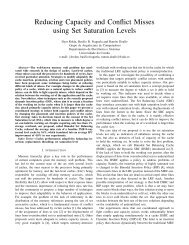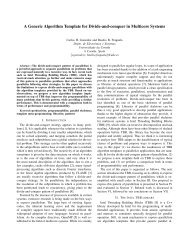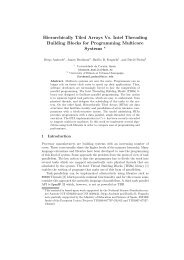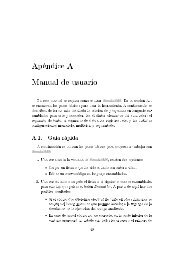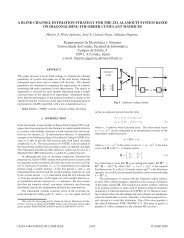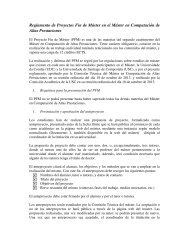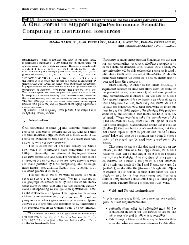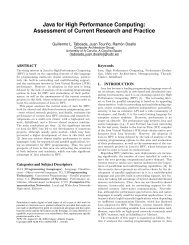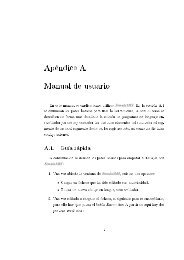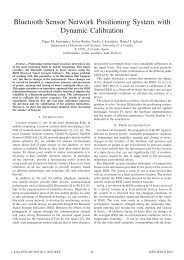1150 D. RAMÍREZ ET AL.without any channel state information (CSI) knowledgeat transmission and with very simple encoding anddecoding procedures. The special structure of OSTBCsimplies that the optimal maximum likelihood (ML)decoder is a simple linear receiver, which can be seen asa matched filter (MF) followed by a symbol-by-symboldetector. This linear receiver also maximizes the signalto-noiseratio (SNR) for each data symbol [9] using theknowledge of the channel matrix.The CSI required for coherent detection of OSTBCsis typically acquired by sending a training sequencethat is known at the receiver side [10]. However,the price to be paid is reduced bandwidth efficiencyand energy loss because training sequences do notcarry information. Popular approaches to avoid theselimitations include the so-called Differential STBC(DSTBC) schemes [11–13] and Unitary Space-TimeModulation [14,15], which do not require channelknowledge at the receiver. However, these approachesincur a penalty in performance of 3 dB (differentialcoding) and 2–4 dB (unitary modulation) as comparedto the coherent ML receiver [14]. Moreover, thereceiver complexity for the unitary scheme increasesexponentially with the number of points in the unitaryspace-time constellation.In order to overcome the limitations of differentialcodes while, at the same time, avoiding the bandwidthreduction of pilot-aided techniques, several methodsfor blind channel estimation have recently beenproposed [16,17]. These methods can be dividedinto two groups depending on whether they exploitthe higher-order statistics (HOS) or the second-orderstatistics (SOS) of the signals. HOS-based methodsexhibit two major drawbacks: they present, in general,a higher computational cost and may require longstreams of data to achieve accurate estimates. For thesereasons, SOS-based methods are preferable in practice.Recently, a reduced-complexity SOS-based method forblind channel estimation under OSTBC transmissionshas been proposed in [18]. Its performance has beenevaluated by means of numerical examples, finding thatin most cases it renders accurate channel estimates,provided that n R > 1 receive antennas are available.However, for some OSTBCs (including Alamouti)some ambiguities appear that have to be avoided using,for instance, linear precoding at the transmitter orresorting to HOS.In this paper, we focus on the evaluation of several ofthe above STBC transmission techniques over realisticindoor scenarios. To this end, we make use of a 2 × 2<strong>MIMO</strong> <strong>testbed</strong> designed to operate at the 2.4 GHzIndustrial, Scientific and Medical (ISM) band. Dueto the limitations in the number of transmit antennas,we are constrained to the Alamouti code [7] and theDSTBC for two transmit antennas [11]. For Alamouticoherent decoding, we have employed a pilot-aidedCSI estimation technique [10] and the blind techniqueproposed in [19], which avoids the indeterminacyproblems of [18] by reducing in a few bits per secondthe transmission rate.The organization of this paper is as follows. InSection 2 the data model for STBC <strong>MIMO</strong> systemsis introduced. Section 3 particularizes this model toOSTBC transmissions and describes the trained andblind channel estimation methods used for coherentdetection. In Section 4 we review the encoding anddecoding of non-coherent DSTBCs. Section 5 presentsthe 2 × 2 <strong>MIMO</strong> platform used to carry out themeasurements. Section 6 compares the utilized <strong>MIMO</strong>platform with existing <strong>testbed</strong>s. Section 7 describes theexperimental results and presents a comparative studyof the different STBC transmission schemes. Finally,the main conclusions are summarized in Section 8.1.1. NotationIn this paper we will use bold-faced upper case lettersto denote matrices, for example, X, with elementsx i,j ; bold-faced lower case letters for column vectors,for example, x, and light-face lower case letters forscalar quantities. The superscripts (·) T and (·) H denotetranspose and Hermitian, respectively. The real andimaginary parts of a complex quantity will be denotedas R(·) and I(·), and superscript (·) ˆ will denoteestimated matrices, vectors or scalars. The trace, range(or column space), and Frobenius norm of matrixA will be denoted as Tr(A), range(A), and ‖A‖,respectively. The notation A ∈ C M×N and A ∈ R M×Nwill be used to denote that A is a complex or real matrixof dimension M × N. Finally, the identity matrix ofdimensions p × p will be denoted as I p (althoughthe subindex will be omitted when confusion is notpossible) and E[·] will denote the expectation operator.2. Data Model for <strong>MIMO</strong> STBC SystemsThroughout this paper, we will assume a flat fading<strong>MIMO</strong> channel model with n T transmit and n R receiveantennas. The n T × n R complex channel matrix is⎡⎤h 1,1 ··· hH = [ 1,nR] h 1 ···h nR = ⎢ . ⎣ . .. ⎥ . ⎦ ,h nT ,1 ··· h nT ,n RCopyright © 2007 John Wiley & Sons, Ltd. Wirel. Commun. Mob. Comput. 2008; 8:1149–1164DOI: 10.1002/wcm
STBC TRANSMISSIONS USING A <strong>MIMO</strong> TESTBED 1151where h i,j denotes the channel response between the ith valued extended code matricescomplex vectors w k (h j ) and real vectors ˜w k (h j ) =[R(wk (h j )) T , I(w k (h j )) T] T we can define the real- ˜W T (H) ˜W(H) =‖H‖ 2 I (2)transmit and the jth receive antennas, and h j contains[ ]the channel response associated with the jth receiveR(Ck ) −I(C k )antenna.˜C k =I(C k ) R(C k )Let us consider a space-time block code transmittingM symbols during L time slots and using n T antennasat the transmitter site. The transmission rate is definedwhich implyas R = M/L and the symbols of the nth data block aredenoted as r k [n], k = 1,...,M. Depending on whether˜w k (h j ) = ˜C k ˜h j (1)r k [n] is complex or real, the number of real symbols,M ′ , transmitted in each block iswith ˜h j = [ R(h j ) T , I(h j ) T] T .Defining now the real vectors ỹ j [n] ={ [M for real constellations,R(yj [n]) T , I(yM ′ j [n]) T] T and ñj [n] = [ R(n j [n]) T ,=2M for complex constellationsI(n j [n]) T] T , the above equation can be rewritten asFor a STBC, the nth block of data can be expressed in∑M ′ỹterms of the transmitted real symbols asj [n] = ˜w k (h j )s k [n] + ñ j [n]k=1∑M ′= ˜W(h j )s[n] + ñ j [n]S[n] = C k s k [n]k=1where s[n] = [s 1 [n],...,s M ′[n]] T contains theM ′ transmitted real symbols and ˜W(h j ) =where C k ∈ C L×n T, k = 1,...,M ′ , are the STBC[˜w 1 (h j ) ··· ˜w M ′(h j )]. Finally, stacking all thecode matrices, andreceived signals into ỹ[n] = [ ỹ1 T[n],...,ỹT n R[n] ] T ,we can write{R(rk [n]), k ≤ M,s k [n] =ỹ[n] = ˜W(H)s[n] + ñ[n]I(r k−M [n]), k>Mwhere ˜W(H) = [ ˜W T (h 1 ) ··· ˜W T (h nR ) ] T , and ñ[n]isare real symbols. In the case of real STBCs, the code defined analogously to ỹ[n].matrices C k and therefore the transmitted matrix S[n]are real.The signal at the jth receive antenna isWhen H is known at the receiver, and assuming aGaussian distribution for the noise, the coherent MLdecoder amounts to minimizing the following criterion[20]∑M ′∥y j [n] = S[n]h j + n j [n] = w k (h j )s k [n] + n j [n]ŝ[n] = argmin ∥ỹ[n] − ˜W(H)s[n] ∥ 2k=1s[n]where n j [n] is spatial and temporally white complex subject to the constraint that the elements of ŝ[n] belongnoise with variance σ 2 and w k (h j ) represents the to a finite set S. This is a NP-hard problem and optimalcombined effect of the STBC and the jth channel, which algorithms to solve it, such as sphere decoding, can beis given bycomputationally expensive [4,21–23].w k (h j ) = C k h j ,3. Orthogonal STBCsfor k = 1,...,M ′ .In the case of orthogonal STBCs (OSTBCs), the matrixTaking into account the isomorphism between ˜W(H) satisfiesCopyright © 2007 John Wiley & Sons, Ltd. Wirel. Commun. Mob. Comput. 2008; 8:1149–1164DOI: 10.1002/wcm



